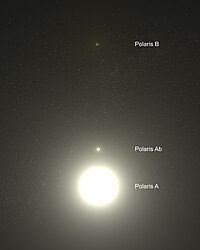Portal:Stars/Selected stars/5

Polaris (α UMi / α Ursae Minoris / Alpha Ursae Minoris, commonly North(ern) Star or Pole Star, or Dhruva Tara and sometimes Lodestar) is the brightest star in the constellation Ursa Minor. It is very close to the north celestial pole (42′ away as of 2006[update], making it the current northern pole star.
Polaris is about 430 light-years from Earth and is a multiple star. α UMi A is a six solar massWieland page 3: masses of A and P ... (6.0+1.54M⊙) F7 bright giant (II) or supergiant (Ib). The two smaller companions are: α UMi B, a 1.5 solar mass F3V main sequence star orbiting at a distance of 2400 AU, and α UMi Ab, a very close dwarf with an 18.5 AU radius orbit. There are also two distant components α UMi C and α UMi D. Recent observations show that Polaris may be part of a loose open cluster of type A and F stars.
Polaris B can be seen even with a modest telescope and was first noticed by William Herschel in 1780. In 1929, it was discovered by examining the spectrum of Polaris A that it had another very close dwarf companion (variously α UMi P, α UMi a or α UMi Ab), which had been theorized in earlier observations (Moore, J.H and Kholodovsky, E. A.). In January 2006, NASA released images from the Hubble telescope, directly showing all three members of the Polaris ternary system. The nearer dwarf star is in an orbit of only 18.5 AU (2.8 billion km; about the distance from our Sun to Uranus) from Polaris A, explaining why its light is swamped by its close and much brighter companion.
Polaris is a classic Population I Cepheid variable (although, it was once thought to be Population II due to its high galactic latitude).
